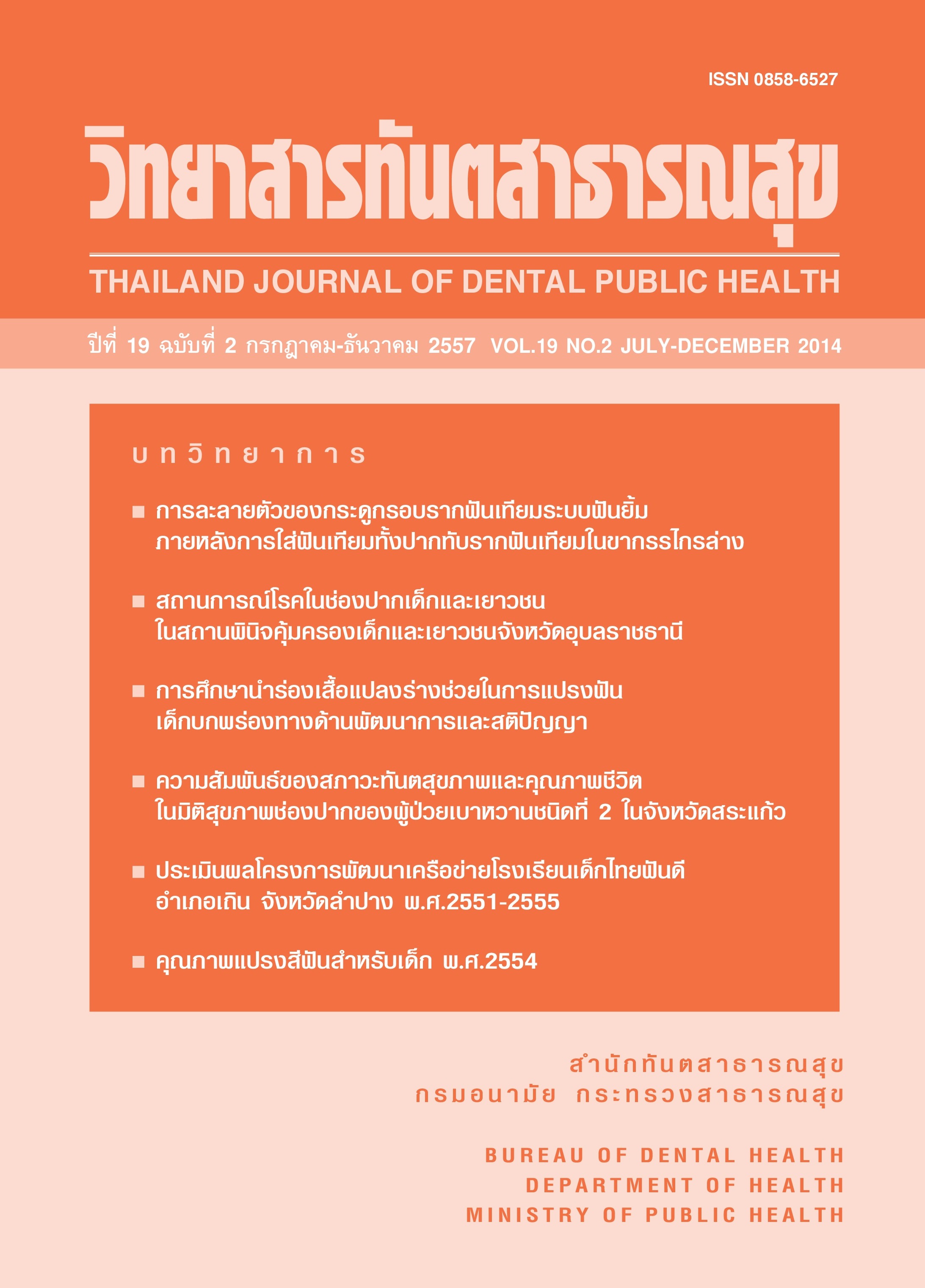Marginal bone loss adjacent to Implant-Retained Mandibular Overdentures:Fun-Yim Implant System
Main Article Content
Abstract
This descriptive study aimed to evaluate the marginal bone loss of the implant-retained mandibular overdentures. 96 patients were treated by Fun-Yim Implant System at the Dental Department of Pranangklao hospital, Nonthaburi province between April 2008 to October 2011. Only 58 cases were chosen to be the sample of this study as the result of completeness of radiography periodically. The mean age of sample was 66.7 years, 69.0 percent was female and 31.0 percent was male. Eighteen months after implantation, 60.3 and 63.8 percent of implant in 33-34 area and 43-44 area respectively had the bone level at polishing surface of implant. The marginal bone loss of most implants was not exceed one-third of the length of implant. All of implants showed no peri-implant radiolucent.
Downloads
Article Details
References
2. Redford M, Drury TF, Kingman A, Brown LJ. Denture Use and Technical Quality of Dental Prostheses Among Persons 18-74 Years of Age: United States 1988-1991. J Dent Res. 1996;75:714-25.
3. Zitzmann NU, Sendi P, Marinello CP. An economic evaluation of implant treatment in edentulous patients-preliminary results.Int J Prosthodont. 2005;18:20-7.
4Heydecke G, Locker D, Awad MA, Lund JP, Feine JS. Oral and general health-related quality of life with conventional and implant dentures. Community Dent Oral Epidemiol.2003;31:161-8.
5. Thomason JM, Lund JP, Chehade A, Feine JS.Patient satisfaction with mandibular implant overdentures and conventional dentures 6 months after delivery.Int J Prosthodont. 2003;16:467-73.
6. Att W, Stappert C. Implant therapy to improve quality of life. Quintessence Int.2003;34:573-81.
7. Meijer HJ, Raghoebar GM, Van’t Hof MA. Comparison of implant-retained mandibular overdentures and conventional complete dentures: a 10-year prospective study of clinical aspects and patient satisfaction. Int J Oral maxillofac Implants. 2003;18:879-85.
8. Adell R, Lekholm U, Rockler B, Branemark P-I. A 15-year study of osseointegrated implants in the treatment of the edentulous jaw. Int J Oral Surg. 1981;10:387-416.
9. Smith DE, Zarb GA.Criteria for success of osseointegratedendosseous implants.J Prosthet Dent. 1989;62:567-72.
10. Cehreli MC, Karasoy D, Kokat AM, Akca K, Eckert S. A systematic review of marginal bone loss around implants retaining or supporting overdentures. Int J Oral and Maxillofac Implants. 2010;25:266-77.
11. De Smet E, Duyck J, vanderSloten J, Jacobs R, Naert I. Timing of loading-immediate,early or delayed-in the outcome of implants in the edentulous mandible: a prospective clinical trial. Int J Oral and Maxillofac Implants. 2007;22:580-94.
12. Rutkunas V, Mizutani H, Puriene A. Conventional and early loading of two-implant supported mandibular overdentures. Asystematic review.Stomatologija. 2008;10:51-61.
13. Naert I, Alsaadi G, van Steenberghe D, Quirynen M.A 10-year randomized clinical trial on the influence of splinted and unsplinted oral implants retaining mandibularoverdentures: peri-implant outcome.Int J Oral Maxillofac Implants. 2004;19:695-702.
14. AlbrektssonT, Zarb G, Worthington P, Eriksson AR. The long-term efficacy of currently used dental implants: a review and proposed criteria of success. Int J Oral and Maxillofac Implants. 1986;1:11-25.
15. Wedgwood D, Jennings KJ, Critchlow HA, Watkinson AC, Shepherd JP, Frame JW, et al. Experience with ITI osseointegrated implants at five centres in the UK. Br J Oral Maxillofac Surg. 1992;30; 377-81.
16. Karoussis IK, Muller S, Salvi GE, Heitz-Mayfield LJ, Bragger U, Lang NP. Association between periodontal and peri-implant conditions: a 10-year prospective study. Clin Oral Implants Res. 2004;15:1-7.
17. Misch CE, Perel ML, Wang HL, Sammartino G, Galindo-Moreno P, TrisiP,etal.Implant success, survival, and failure: the International Congress of Oral Implantologists (ICOI) Pisa Consensus Conference.Implant Dent. 2008;17:5-15.
18. Elsyad MA, Al-Mahdy YF, Fouad MM. Marginal bone loss adjacent to conventional and immediate loaded two implants supporting a ball-retained mandibular overdenture: a 3-year randomized clinical trial. Clin Oral Implants Res. 2012;23:496-503.
19. Balshi TJ, WolfingerGJ. Immediate loading of Branemark implants in edentulous mandible: a preliminary report. Implant Dent. 1997;6:83-8.
20. Lindquist LW, Carlson GE, Jemt T. A prospective 15 years follow-up study of mandibular fixed prostheses supported by osseointegrated implants.Clinical results and marginal bone loss.Clin Oral Implants Res. 1996;7:329-36.
21. Davis D,Packer ME. The maintenance requirements of mandibular overdentures stabilized by Artra Tech implants using 3 different attachment mechanisms-balls, magnets and bars;3 year results.Eur J ProsthodontRestor Dent. 2000;8:131-4.
22. Wismeyer D, van Waas MA, Veemeeren JI. Overdentures supported by ITI implants: a 6.5-year evaluation of patient satisfaction and prosthetic aftercare. Int J Oral Maxillofac Implants. 1995;10:744-9.
23. Mombelli A, Lang NP. Clinical parameters for the evaluation of dental implants.Periodontology 2000. 1994;4:81-6.
24. Buser D, Mericke-Stern R, Bernard JP, Behneke A, Behneke N, Hirt HP, et al. Long-term evaluation of non-submerged ITI implants. Part 1:8-year life table analysis of a prospective multi-center study with 2359 implants. Clin Oral Implants Res. 1997;8:161-72.
25. Albrektsson TO, Johansson CB, Sennerby L. Biological aspects of implant dentistry: osseointegration. Periodontology 2000. 1994;4:58-73.


